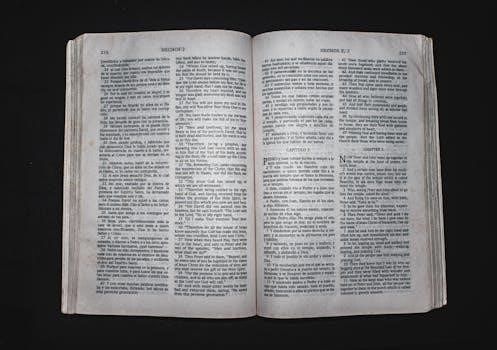latin vulgate bible in english pdf

The Latin Vulgate Bible⁚ An Overview
The Latin Vulgate, a late 4th-century translation, became the Roman Catholic Church’s definitive Latin Bible in the 16th century. St. Jerome meticulously translated it from Hebrew and Greek. This version, known as the versio vulgata, gained widespread use across the Latin-speaking West and was used for many translations into vernacular languages.
What is the Latin Vulgate?
The Latin Vulgate is a late 4th-century Latin translation of the Bible, primarily the work of St. Jerome. It was commissioned by Pope Damasus I and completed around 405 CE. The term “Vulgate” derives from the Latin versio vulgata, meaning “common translation,” highlighting its intended use by the general populace. St. Jerome translated the Old Testament mostly from Hebrew, while for the New Testament, he relied primarily on the Greek manuscripts. The Vulgate is not to be confused with the term “vulgar,” which has a quite different meaning. This version became the standard biblical text for the Roman Catholic Church for over a millennium. It was declared authentic by the Council of Trent in 1546, further solidifying its authority. Before the publication of Pius XIIs Divino afflante Spiritu, the Vulgate was the source text used for many translations of the Bible into vernacular languages. The Latin text presented in many sources is based on the 1598 Vulgate, which served as the standard until 1979. The Vulgate’s influence is far-reaching, impacting not only religious texts but also literature and language in Western cultures.
St. Jerome and the Vulgate’s Creation
St. Jerome, a renowned scholar and theologian of the 4th and 5th centuries, is the central figure in the creation of the Latin Vulgate. Born around 347 AD, he possessed extensive knowledge of Latin, Greek, and Hebrew. Pope Damasus I commissioned Jerome to revise the existing Old Latin translations, aiming for a more accurate and unified version. Jerome embarked on this monumental task, working meticulously for many years. He first revised the Gospels and then, after moving to Bethlehem, he translated the Old Testament from Hebrew. His approach was to render the original text as faithfully as possible into the common Latin of the time. Jerome’s work was not without controversy, as some disagreed with his revisions. However, his commitment to accuracy and his profound understanding of the biblical languages led to a translation of immense influence. His translation was completed in 405 CE and has been used regularly since that time. The widespread use of the Vulgate is also recognizable in various cultural and religious contexts.
The Vulgate’s Role in the Catholic Church
The Latin Vulgate holds a pivotal position in the history of the Catholic Church. In 1546, the Council of Trent officially declared the Vulgate as the authentic and authoritative version of the Bible, thus solidifying its status for centuries. This declaration meant that the Vulgate became the standard text used in liturgy, theology, and scholarship within the Church. It was the basis for countless sermons, commentaries, and theological treatises. Before the publication of Pius XII’s Divino afflante Spiritu, the Vulgate served as the source text for many translations of the Bible into vernacular languages. The Vulgate’s influence extended beyond theological circles, shaping Western culture and literature. Its Latin prose became embedded in the collective consciousness and influenced the development of several European languages. Even today, the Vulgate remains important for its historical and cultural significance, and is still used in the Traditional Latin Mass. The Neo-Vulgate or Nova Vulgata is the current official Latin translation for liturgical books.

English Translations of the Latin Vulgate
The Latin Vulgate has been translated into English multiple times, with the Douay-Rheims being a notable version. Other translations and resources exist, providing access to the Vulgate’s text alongside English versions for study and comparison.
The Douay-Rheims Version
The Douay-Rheims Bible stands as a significant English translation of the Latin Vulgate, holding a place of importance in the history of English Bible translations. It was produced by English Catholic scholars at the colleges of Douai and Rheims in France during the late 16th and early 17th centuries. The New Testament was published in Rheims in 1582, while the Old Testament followed in Douai in 1609. This translation was created partly in response to the emergence of Protestant vernacular Bibles, aiming to provide a Catholic alternative based on the Vulgate. The Douay-Rheims version is known for its close adherence to the Latin text, often reflecting the nuances of its language. The language it used was considered archaic by some standards, which can make it challenging for modern readers. Nevertheless, it remains influential within Catholic tradition and has been used by many scholars, providing an important view on the Vulgate. Its purpose was to combat rival theologies during a time of religious conflict and to give to the English speaking Catholics their own Bible.
Other English Translations and Resources
Besides the Douay-Rheims, several other resources offer English access to the Latin Vulgate. Some modern translations aim for a more accessible English, while others provide parallel text versions, aligning the Latin Vulgate with its English counterpart. These resources are essential for those studying the Vulgate and the history of Bible translation; Many online platforms and digital libraries provide access to the Vulgate and its English translations. These resources allow for easier research and comparison between various versions. Some digital texts include the Latin Vulgate alongside the English Douay-Rheims version, while others present the Vulgate with modern English renditions. The use of digital tools has made the study of the Vulgate more accessible, including options for searching and analyzing the text. Additionally, some resources provide commentary and analysis, which gives an added layer of understanding to the text. Resources are available in several formats, including books, websites, and PDF documents, which cater to the different needs of users. These resources have made the study of the Vulgate much more accessible for both scholars and general readers.

Availability of the Latin Vulgate in PDF Format

The Latin Vulgate is widely available in PDF format, allowing for easy digital access. These PDFs often include the Latin text, and sometimes an English translation, facilitating its study and comparison. Numerous online resources offer these files for download.

Digital Access and Online Resources
The digital age has made accessing the Latin Vulgate significantly easier, with numerous online resources offering PDF versions of this important text. These resources often include not only the Latin text itself, but also, in many cases, parallel English translations. This allows for convenient side-by-side comparison, aiding both scholars and individuals interested in studying the Vulgate. These online platforms provide various editions, including the 1685 Catholic Latin Vulgate PDF, also known as the Biblia Sacra Vulgate Edition. Some sites offer the Vulgate alongside the Douay-Rheims English translation, a popular version based on the Vulgate. Further, certain projects focus on digitalizing the Vulgate, such as the Clementine Vulgate Project, making the text accessible to a broader audience. Many websites provide the Vulgate text derived from these projects. Additionally, some resources even include translation notes or commentary alongside the text, making it more user-friendly for those delving into its nuances. These various online resources have made the Latin Vulgate more accessible than ever before.
Considerations when using PDF versions
While PDF versions of the Latin Vulgate offer convenient access, there are important considerations to keep in mind. One must be careful when using ancient texts in digital form, and it is advisable to compare different editions or reprints. This is because some texts may be lost or rendered unreadable due to age or the process of digitization. Therefore, relying solely on a single PDF version may not be ideal, especially for scholarly purposes. It’s wise to utilize resources that state the source of the PDF, such as those derived from the Clementine Vulgate Project. Also, some automatically converted texts may lack essential features like book introductions, titles, and proper paragraph formatting, so it would be beneficial to compare it with a print edition if possible. Moreover, it’s important to verify the translation source and be aware of any associated biases or methodologies of the translators. Being aware of the limitations inherent in digital texts will lead to more informed use of PDF versions of the Latin Vulgate.
Project for a New English Translation of the Vulgate
A significant project is underway to create a new English translation of the Vulgate and Vetus Latina. This endeavor involves several key steps to ensure accuracy and accessibility. First, it entails collating all known manuscripts of the Old Latin Bible, which are the predecessors to the Vulgate. Secondly, biblical citations from early Latin Church Fathers are also being compiled, as they offer invaluable insights into the understanding of the texts. A crucial part of this project is the production of a Greek text of the New Testament that closely reflects the original text used by Jerome in his Vulgate translation. Finally, a PDF version of both the Vulgate and Vetus Latina will be made available for download as well as a new English translation. This ambitious project seeks to provide scholars and the public with a comprehensive and reliable resource for studying these important biblical texts, bridging the gap between the ancient Latin and modern English.